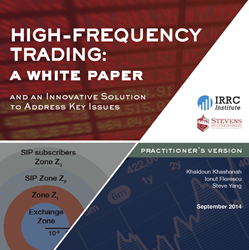New Stevens Research Explains High-Frequency Trading; Offers Potential Solution to Address Key Issues


Hoboken, NJ (PRWEB) September 04, 2014
New academic research from Stevens serves as guide to high-frequency trading proposing an innovative solution to mitigate key problems created by high-frequency trading while simultaneously maintaining its benefits. The research from sets forth a new “information transmission zoning” concept solution.
Traders located within the innermost zone – defined as the zone wherein the trader receives prices prior to the general market – would be considered market makers and therefore be required to obey Securities and Exchange Commission (SEC) market maker regulations. Traders outside this zone could act as traders. Drawing this distinction would create a fair playing field with respect to the dissemination of price information without decreasing liquidity. Additionally, adopting this approach would require minimal financial information flow re-architecting, would build on the SEC’s National Market System (NMS), and would not require any major change in regulation or regulatory authority, according to the authors
Commissioned by the Investor Responsibility Research Center Institute (IRRCi), the research was conducted by Khaldoun Khashanah, Ph.D., Ionut Florescu, Ph.D. and Steve Yang, PhD., all of Stevens Institute of Technology Financial Engineering Division.
Jon Lukomnik, IRRCi executive director said, “The disruptive nature of high frequency trading technology is feeding into the perception that traders are gaming the system. So the question is: How do you keep the benefits, mitigate the problems and eliminate any unfairness? Finding a solution is an imperative, or we risk compromising trust in and the integrity of the financial markets. We hope this new research provides a sensible solution that can be implemented with little pain and big gain,” he said.
“High-frequency trading is a highly disruptive technology that has turned upside down traditional relationships between physical distance, time and information flow. Before us now are complex issues of how to regulate this unchartered territory of micro-second trading and the inter-relationships between space, time, information flow, market structure and trading rules,” says Khaldoun Khashanah, Ph.D, report lead author with Stevens Institute of Technology Financial Engineering Division.
He explained, “Our examination of these new inter-relationships has resulted in our concept of information transmission distance, or how long it takes to get financial information from point A to point B in this new world of computer-generated algorithmic trading that moves virtually at the speed of light. Understanding information transmission distance criteria and systemic latency leads to our concept of ‘information transmission zoning’ that can be applied in conjunction with the SEC’s National Market System without the need for major, new regulations.
“The ‘traditional’ investor represent a, sizable, long-horizon portion of the equities market, while high-frequency trading is a transient component that can trigger substantial market instability. Our research seems to offer a pragmatic solution where investors – whether high or low frequency; whether holding for milliseconds or years – can coexist in the same market while adhering to trading rules for access, fairness, and transparency,” Khashanah concluded.
A practitioner summary of the research, High Frequency Trading: A White Paper and an Innovative Solution To Address Key Issues, is available here.
The full academic research study, On The Impact and Future of HFT: White Paper, is available here.
A webinar to review the research and respond to questions is scheduled for Wednesday, September 24, 2014, at 11 AM ET. Register here or at https://www1.gotomeeting.com/register/681845673.
Stevens Institute of Technology Stevens Institute of Technology, The Innovation University, is a premier, private research university situated in Hoboken, N.J. overlooking the Manhattan skyline. Founded in 1870, technological innovation has been the hallmark and legacy of Stevens’ education and research programs for more than 140 years. Within the university’s three schools and one college, more than 6,100 undergraduate and graduate students collaborate with more than 350 faculty members in an interdisciplinary, student-centric,entrepreneurial environment to advance the frontiers of science and leverage
technology to confront global challenges. Stevens is home to four national research centers of excellence. More information is available at http://www.stevens.edu.
The Investor Responsibility Research Center Institute is a nonprofit research organization that funds academic and practitioner research that enables investors, policymakers, and other stakeholders to make data-driven decisions. IRRCi research covers a wide range of topics of interest to investors, is objective, unbiased, and disseminated widely. More information is available at http://www.irrcinstitute.org.
Find More Technology Press Releases
I really like your blog.. very nice colors & theme.
Did you create this website yourself or did you hire someone
to do it for you? Plz answer back as I’m looking to construct my
own blog and would like to know where u got this from.
thank you
My homepage; Virtual Office Business Address San Francisco
You can contact us using the contact form on the website.
Regards,
Admin